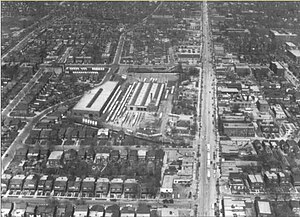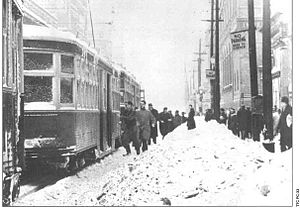Yonge streetcar line
The Toronto Transit Commission operated a Yonge streetcar line, on Yonge Street, from its creation from earlier private systems, in 1921, until the line was replaced by a heavy rail subway line, the Yonge Subway line, in 1954.[1][2][3] The TTCs Yonge line was its busiest and most congested, and the subway that replaced it was not only Toronto's first, but the first in Canada.
In 1885, prior to the TTC era, the Toronto and York Radial Railway introduced ′″radial″′′ streetcar service that connected Toronto to smaller municipalities north, of the city.[4] By 1909 this service had stretched all the way to Sutton, Ontario, on the shores of Lake Simcoe. The TTC continued to operate the radial service until 1930, planning to serve northern municipalities with diesel buses. However, the municipalities of Richmond Hill and York Township sponsored the resumption of service as far as Richmond Hill.
For the last several decades of streetcar service the TTC operated the Yonge line using Peter Witt Streetcars.[1] Even when the TTC operated a large fleet of more modern PCC streetcars they continued to use Peter Witt streetcars on Yonge. Peter Witt cars could be operated in pairs, using special cars called ′′″trailers″′′.
rough work
[1][2][3] The TTCs Yonge line was its busiest and most congested, and the subway that replaced it was not only Toronto's first, but the first in Canada.
References
- ↑ 1.0 1.1 1.2
Ray Neilson. Torontos Yonge Line, from Trailer Trains to subway, GPS Video. Retrieved on 2014-02-20. “Yonge Street was one of Toronto’s first horse car lines to be converted to electric street cars in 1890.”
Cite error: Invalid
<ref>tag; name "GpsVideoYonge" defined multiple times with different content Cite error: Invalid<ref>tag; name "GpsVideoYonge" defined multiple times with different content - ↑ 2.0 2.1
Mike Filey. From Horse Power to Horsepower: Toronto: 1890-1930, Dundurn Press, 1996, p. 74. Retrieved on 2014-02-17. “Over the years this route was extended westerly, first to Runnymede Road, then, two years after the TTC was formed, the new JANE loop that opened on the last day of 1923.”
Cite error: Invalid
<ref>tag; name "FileyHorsepower" defined multiple times with different content Cite error: Invalid<ref>tag; name "FileyHorsepower" defined multiple times with different content - ↑ 3.0 3.1
Mike Filey (2008). Toronto: The Way We Were. Dundurn Press. ISBN 9781550028423. Retrieved on 2014-02-17. “Many long-time Torontonians will remember when streetcars--often in the form of so-called M-Us (multiple-units consisting of a pair of coupled PCC streamliners)--would shuttle between the two legendary streetcar loops, Jane on the west and Luttrell on the east. They were usually jammed to the doors. The Jane-Luttrell (or if you were headed in the other direction, Luttrell-Jane) service was introduced in the mid-1920s and remained in its entirety until the Bloor-Danforth subway opened in 1966.”
Cite error: Invalid
<ref>tag; name "MikeFiley2008" defined multiple times with different content Cite error: Invalid<ref>tag; name "MikeFiley2008" defined multiple times with different content - ↑ Mike Filey. Toronto Sketches 11: "The Way We Were" (text), Dundurn Press, 2012, pp. 175-176. Retrieved on 2014-02. (in English)
- ↑ Mike Filey (1997). The TTC Story: The First Seventy-five Years (text). Dundurn Press. ISBN 9781770700796. Retrieved on 2014-02-17.

